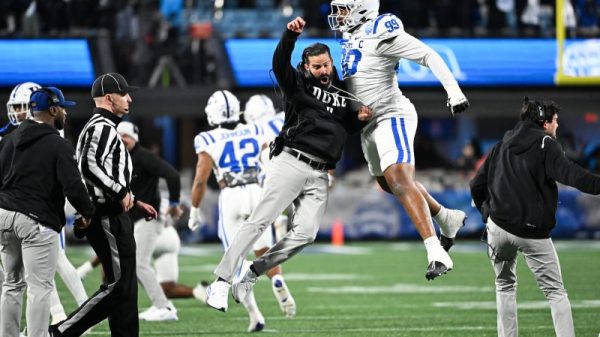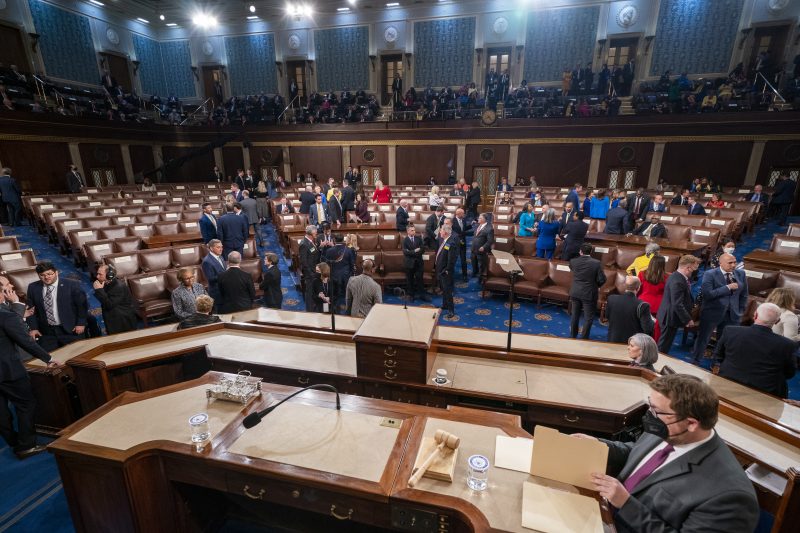Once upon a time, in the earlier days of this American republic, the president complied with the constitutional mandate to update Congress on the state of the union with a written letter. These are compiled in various places. Here, for example, is Abraham Lincoln’s letter from 1861, in which he notes that “a disloyal portion of the American people have during the whole year been engaged in an attempt to divide and destroy the Union.” So, you know, just an update.
There are numerous inherent advantages to a written compilation of the state of affairs, both to the chief executive and to the public at large. For one, you can read a lot more in five minutes than you can hear, allowing presidents to be less bound to the constraints of time — to the extent that any ever have been. For another, it’s easier for readers to check what’s being presented for context or validation. Beyond the slow evolution of technology, there’s a reason that schools rely on textbooks more than video presentations.
But a televised State of the Union offers intangibles beyond the conveyance of information. It guarantees blanket television coverage for a speech that’s inherently political, for one. For another, it is a celebration of institutional Washington, not only of the heft of the presidency but the importance of the legislature — so lawmakers and other D.C. officials obviously love it.
Is that enough to warrant preserving this still relatively young tradition of gathering everyone together and giving them an opportunity to speak/react to a speech? I offer that it is not.
We will in a moment consider the benefits that a televised State of the Union address is meant to offer and whether televising it is necessary to obtain those benefits. But let’s first dispatch with the idea that the address is in any real sense an update on the state of the country. This isn’t 1820; we get data and research on how America is doing and on the condition of each of the federal government’s countless tendrils on an hourly basis. It is, instead, an effort to take an update that the Constitution says must happen — that the president should “from time to time give to the Congress Information of the State of the Union, and recommend to their Consideration such measures as he shall judge necessary and expedient” — and turn it into an update about the president.
So what does this speech theoretically achieve?
The speech allows the president to outline his priorities. This is certainly true. State of the Union addresses are replete with proposals for policy and executive action aimed at fixing whichever problems the president and his party have identified.
But, again, this need not be televised. In 1981, Jimmy Carter, then a lame-duck president, offered Congress a nearly 34,000-word letter updating the legislative branch on how he saw the state of the country. He was able to go into exhaustive detail that wouldn’t fit in a televised speech. (His 1980 speech was about 3,500 words and took half an hour to deliver, meaning that reading his 1981 speech would have taken about five hours.) There was no real use in his leveraging the tradition of the address for political purposes; his career in elected politics was over. But it’s hard to see how the 1980 speech offered more detail on his priorities than his 1981 letter.
What’s more, it’s not often the case that these priorities turn into actual policy. The Washington Post’s Glenn Kessler reviewed President Biden’s 2022 address to see how his efforts compared with his accomplishments; they did on occasion. Research cited by FiveThirtyEight suggests that such success is relatively unusual. (That article, incidentally, argues for the State of the Union address, making it a useful companion piece to this one — and reinforcing the utility of being able to compare written documents.)
Regardless, it’s not as though 1) a written letter wouldn’t similarly convey those priorities and 2) those priorities wouldn’t become obvious as Biden and his party were advocating specific legislation. Many of his successes were part of the Inflation Reduction Act. I suspect very few Americans considered the contents of that legislation and recalled Biden’s State of the Union rhetoric.
This is an important point on its own. The speech could conceivably be a way of building political will and consensus for policy priorities. George W. Bush tried to build support for the imminent war in Iraq during his 2003 speech, but opposition to the invasion continued to climb regardless. And that was back when people were tuning in to hear the president’s rhetoric directly.
The speech attracts millions of viewers. It is still the case that Biden can count on a large television audience for his speech. But tens of millions of viewers in a population of more than 330 million is relatively modest. Ratings from Nielsen show that while the equivalent of a third of the country watches the Super Bowl, only about a tenth watches State of the Union addresses. (Pedants will note that I’m using the term “State of the Union address” to refer to both first-year addresses to joint sessions of Congress and formal State of the Union speeches, because that distinction is itself annoying.) The president is doing better than the Oscars, but that’s not saying much.
It is true that lots of people hear the contents of the speech through later media coverage and clips shared online, as FiveThirtyEight points out. But, again, this does not require a televised address to accomplish. A delineation of policy goals can and should itself receive media coverage that informs Americans about what a president seeks to do. What’s more, a more detailed presentation of the state of the country and the president’s policy outcomes offers more studiously inclined Americans a meatier dish.
Millions of people watch the speech, and there is probably an argument to be made that a large subset of them would not pay attention to what the president is doing were he not preempting “NCIS.” (Pedants will note that “NCIS” airs on Mondays.) But it seems safe to say that those who watch the State of the Union are already more inclined to be up on political news, meaning they’d probably end up consuming coverage about a written presentation as well.
The speech allows the president to recognize important Americans. One of the nicer parts of the State of the Union address is when the president recognizes guests sitting in the gallery. Small-town heroes, those who’ve overcome adversity, veterans injured in the line of duty — these are worth celebrating when we can, certainly. Perhaps we create an annual event in which the president is given an hour in prime-time television to recognize Americans for their successes and achievements. It need not accompany the State of the Union.
The speech showcases official Washington. This it does, for better or worse.
It is the nature of the event that the things we remember from presidential speeches to Congress center more on what happens than what’s said. House Speaker Nancy Pelosi (D-Calif.) ripping up President Donald Trump’s speech in 2020. Supreme Court Justice Samuel Alito shaking his head at President Barack Obama in 2010. Reps. Lauren Boebert (R-Colo.) and Marjorie Taylor Greene (R-Ga.) trying to heckle Biden last year. These incidents have a longevity that the contents of those speeches don’t.
Modern American politics is heavily centered — for the worse — on achieving a moment that might go viral or earn repeat showing on cable news. If Tuesday night’s address is interrupted by some effort to grandstand in opposition to Biden, none of us should be surprised, nor should we be surprised if that ends up in heavy rotation on Fox News or being tweeted by Donald Trump Jr.
Ahead of the State of the Union tonight, McCarthy and GOP leaders warned Republicans during a closed-door meeting to behave, reminding them that the ‘cameras are on’ and the ‘mics are hot.’
— Melanie Zanona (@MZanona) February 7, 2023
Even in its least toxic iterations, the speech to Congress involves cringey grandstanding. The Post’s Karen Tumulty notes that members of Congress jockey to be seated near the center aisle so they can get on TV shaking the president’s hand. When you give politicians access to live television cameras broadcasting to a large audience, they are not incentivized to reflect the staid solemnity of the institution.
“No president wants to give up the pomp and ceremony,” NBC’s Peter Nicholas writes of the event — “much less the millions of eyeballs trained on him, as he strides through the House chamber after the ringing eight-word cue: ‘Mr. Speaker, the president of the United States!’”
Certainly true. But we must wonder whether the event can survive given that it offers a rare opportunity for attention to an attention-hungry pool of elected officials. The president enjoys the spotlight as he speaks, but the hours before and after have already long attracted political moths. Should that continue to seep into the speech itself, a reversion to written State of the Union messages might naturally follow.
Why not just get ahead of that transition, with the happy side effect of offering the public more, better information as you do it?



























